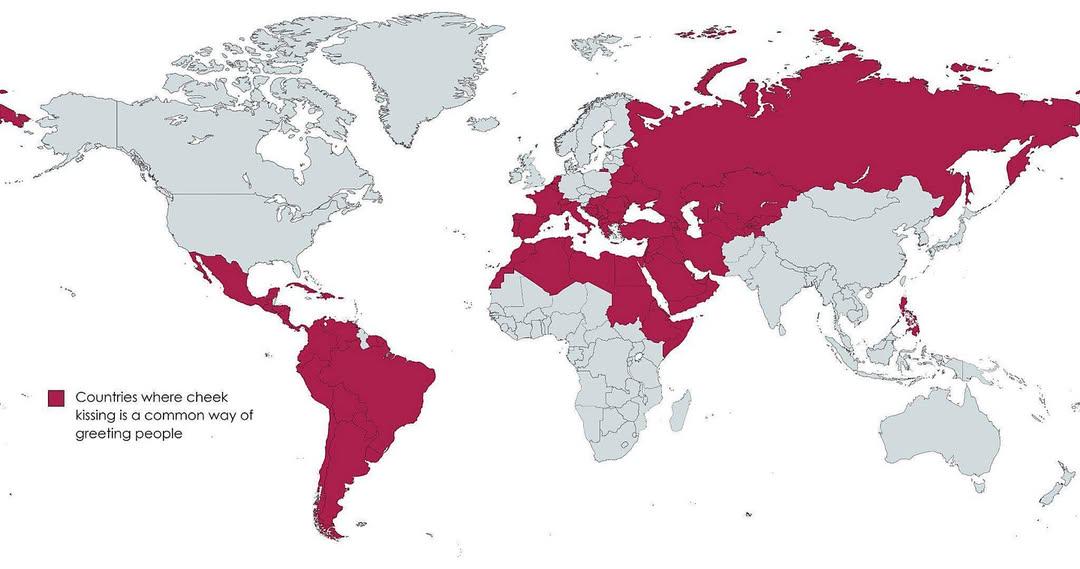Map of Countries with Cheek Kissing Greetings


Marcus Rodriguez
Historical Geography Expert
Marcus Rodriguez specializes in historical cartography and geographic data analysis. With a background in both history and geography, he brings unique...
Geographic Analysis
What This Map Shows
The map titled "Countries where cheek kissing is a customary greeting" visually represents global regions where cheek kissing is a traditional form of greeting. This cultural practice varies widely across nations and is influenced by social norms, historical interactions, and regional traditions. The map highlights specific countries where this form of greeting is commonplace, providing a unique insight into the diverse ways people communicate affection and friendliness.
Deep Dive into Cheek Kissing as a Greeting
Cheek kissing is a fascinating social custom that transcends borders and cultures. It serves as a non-verbal form of communication, often implying warmth, familiarity, and an informal tone. The practice varies significantly from one country to another, including the number of kisses exchanged, the side on which the kiss is given, and even the contexts in which it is appropriate.
In many European countries, particularly in Southern Europe like France, Spain, and Italy, cheek kissing is a prevalent form of greeting. For instance, in France, it is customary to exchange two to four kisses, starting on the cheek, with variations depending on the region. Interestingly, in some parts of the Netherlands, a single kiss on the cheek suffices, while in Belgium, it can go up to three kisses.
The roots of this practice can be traced back to ancient customs, where physical contact signified trust and friendship. In Mediterranean cultures, cheek kissing is often infused with elaborate rituals, including specific greetings that can vary between acquaintances, friends, and family members. The importance of these gestures cannot be understated, as they play a crucial role in social bonding and cultural identity.
In contrast, in Middle Eastern countries, cheek kissing is a common greeting among friends and family, often accompanied by a warm handshake. This practice not only reflects the importance of personal relationships but also highlights the cultural significance of hospitality. For example, in countries like Lebanon and Syria, it is customary to greet with two or three kisses on the cheeks, and it can even extend to close friends of the opposite gender, showcasing a blend of familial warmth and social acceptance.
Interestingly, as globalization influences cultural exchanges, the practice of cheek kissing is also evolving. In some cultures where it was once uncommon, there is a growing acceptance of this greeting style, especially among younger generations. Social media and travel have played pivotal roles in reshaping these interactions, making cheek kissing a more recognized gesture worldwide.
Regional Analysis
The map reveals distinct patterns in the prevalence of cheek kissing as a greeting, particularly across Europe, the Middle East, and parts of Latin America. In Southern European countries such as Italy and Spain, cheek kissing is not just a greeting but part of the cultural fabric, often reflecting a deep sense of community and familial ties.
In France, the practice varies by region, with cities like Marseille known for more enthusiastic greetings compared to the more reserved Paris. Similarly, in Latin American countries like Argentina and Brazil, cheek kissing is a common practice, deeply rooted in the social fabric and often associated with a vibrant lifestyle.
Conversely, in Northern European countries like Sweden and Finland, cheek kissing is less common and often reserved for close friends or family members. Here, a handshake or a nod is more typical, reflecting a more reserved cultural norm. Interestingly, in some Asian countries, such as Japan and China, physical greetings may include bowing instead, highlighting the cultural importance of respect and formality over casual physical affection.
Significance and Impact
Understanding the cultural nuances of greetings, such as cheek kissing, is more than just an exercise in geography; it holds significant implications for social interactions, diplomacy, and global relations. In an increasingly interconnected world, recognizing and respecting these customs can enhance interpersonal relationships and foster mutual respect among diverse populations.
As globalization continues to blur cultural lines, the future of cheek kissing as a greeting may evolve. We may see a broader acceptance of this practice across different cultures, especially among younger generations who are more exposed to international norms through travel and media. The ability to navigate these social customs effectively can play a crucial role in fostering international friendships and collaborations, making cultural literacy an essential skill in the modern world.
In conclusion, cheek kissing serves as a vibrant testament to the diverse ways humans connect. It reflects not just personal affection but also broader social values and traditions that shape our interactions across the globe. Understanding these practices through geographical lenses allows us to appreciate the rich tapestry of human culture and the significance of seemingly simple gestures in our daily lives.
Visualization Details
- Published
- August 17, 2025
- Views
- 224
Comments
Loading comments...